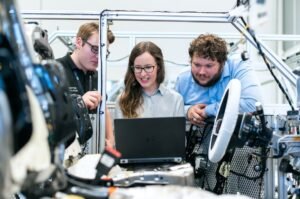What Are Top AI Tools?
Artificial Intelligence (AI) is revolutionizing numerous industries by automating complex and repetitive tasks, enhancing decision-making processes, and enabling innovative solutions. AI tools play a crucial role in utilizing this technology to its full potential. In this article, we will explore some of the top AI tools available in the market today.
Key Takeaways
- AI tools are essential for leveraging the power of Artificial Intelligence.
- These tools automate tasks, enhance decision-making, and spark innovation.
- Top AI tools include chatbot platforms, machine learning frameworks, and natural language processing libraries.
- Choosing the right AI tool depends on specific needs and requirements.
**Chatbot Platforms** are immensely popular AI tools that enable businesses to build intelligent conversational agents for customer service, sales, and support. These platforms utilize natural language processing (NLP) algorithms to understand and respond to user queries effectively. *With the rise of chatbot platforms, businesses can provide seamless and personalized user experiences, driving customer satisfaction and engagement.*
**Machine Learning Frameworks** are a crucial part of the AI ecosystem. They provide the necessary tools and libraries for implementing machine learning algorithms efficiently. These frameworks offer extensive capabilities for data preprocessing, model training, and model evaluation. *With machine learning frameworks, developers can build powerful predictive models based on the data, enabling businesses to make data-driven decisions.*
Comparison of Popular Chatbot Platforms
| Platform | Features | Pricing |
|---|---|---|
| Chatfuel | Visual Chatbot Builder, NLP Integration | Free, Premium Plans Available |
| Dialogflow | Advanced NLP, Multilingual Support | Free, Pay-as-you-go Pricing |
| IBM Watson Assistant | Enterprise-Grade, Contextual AI | Pricing varies based on usage |
**Natural Language Processing (NLP) Libraries** are essential for analyzing and understanding human language. These libraries provide pre-trained models and algorithms for tasks like sentiment analysis, named entity recognition, and text classification. *NLP libraries open up a world of possibilities for AI applications, enabling systems to comprehend and process language like a human.* One popular NLP library is **spaCy**, known for its efficiency and accuracy in natural language processing tasks.
Comparison of Machine Learning Frameworks
| Framework | Features | Programming Languages |
|---|---|---|
| TensorFlow | Large Community, TensorFlow Extended (TFX) | Python, C++, Java |
| PyTorch | Dynamic Computation Graph, TorchVision | Python |
| Scikit-learn | Wide Range of Algorithms, Easy to Use | Python |
Furthermore, **Business Intelligence Tools** also leverage AI to enable organizations to make data-driven decisions. These tools provide advanced analytics capabilities, data visualization, and predictive modeling. With the power of AI, these tools offer valuable insights into business operations and help improve overall performance.
**AI tools encompass a wide range of applications, from chatbot platforms to machine learning frameworks and business intelligence tools. The choice of the right AI tool depends on specific requirements and objectives. By leveraging these tools, businesses can unlock the full potential of Artificial Intelligence and gain a competitive edge in the ever-evolving digital landscape.**

Common Misconceptions
Misconception 1: AI tools can fully replace human intelligence
One common misconception people have about top AI tools is that they have the ability to replace human intelligence entirely. However, it is important to understand that AI, while powerful, is still limited in its capabilities and cannot replicate the full range of human intelligence and creativity.
- AI tools can perform tasks efficiently, but lack critical thinking abilities
- AI tools may make errors or misinterpret data, unlike humans
- Human intelligence involves emotional understanding, which AI cannot emulate
Misconception 2: AI tools are only beneficial for large businesses
Another common misconception is that AI tools are only relevant and beneficial for large businesses with extensive resources. However, this is far from the truth. AI tools have become increasingly accessible and cost-effective, benefiting businesses of all sizes, from startups to enterprises.
- Small businesses can leverage AI tools for automating repetitive tasks
- AI tools can help enhance customer personalization and improve engagement
- Startups can benefit from AI tools for data analysis and insights
Misconception 3: AI tools will replace human jobs entirely
There is a widespread fear that AI tools will lead to massive job losses and unemployment. However, while AI can automate certain tasks, it is more likely to augment human capabilities and create new opportunities rather than completely replace human jobs.
- AI tools can free up human resources for more complex and creative tasks
- New roles and job opportunities will emerge in AI-related fields
- Human judgment and decision-making will remain instrumental alongside AI tools
Misconception 4: AI tools are always biased and unreliable
There is a common misconception that AI tools are inherently biased and unreliable, primarily due to instances of algorithmic bias. While it is true that bias can exist in AI systems, it can be mitigated through proper training, diverse datasets, and ongoing monitoring and adjustment of the algorithms.
- AI tools can be continuously improved and fine-tuned to reduce bias
- Ethical considerations and diverse representation can address bias issues
- Ongoing human oversight is crucial in ensuring the reliability of AI tools
Misconception 5: AI tools are a threat to humanity
Popular culture often portrays AI tools as a dystopian threat to humanity, leading to a misconception that AI is inherently dangerous. While there are potential risks associated with AI, it is important to emphasize that AI tools are developed and utilized with ethical frameworks and safety precautions in mind.
- AI development focuses on responsible innovation and safeguards
- AI tools are designed to assist and enhance human capabilities, not replace them
- Proper regulation and policies can address potential risks and ensure responsible AI deployment

The Rise of Artificial Intelligence
Artificial Intelligence (AI) has become increasingly prevalent in various industries, transforming the way we live and work. From virtual assistants to automated decision-making systems, AI tools have revolutionized the way we interact with technology. This article explores some of the top AI tools used today, providing insights into their capabilities and impact.
Natural Language Processing: Understanding Human Language
Natural Language Processing (NLP) is a field of AI that focuses on enabling computers to understand and process human language. The table below demonstrates some popular NLP tools employed for various applications, including sentiment analysis, language translation, and chatbots.
| Tool | Functionality | Applications |
|---|---|---|
| Google Cloud Natural Language | Identifies sentiment, entities, and syntax | Content analysis, chatbots, social media monitoring |
| IBM Watson | Language translation, sentiment analysis | Virtual assistants, customer service, language localization |
| Amazon Comprehend | Extracts key phrases, sentiment analysis | Market research, social media monitoring, content classification |
Computer Vision: Perceiving and Understanding Visual Data
Computer Vision (CV) algorithms and tools enable machines to interpret and analyze visual data, such as images and videos. The following table showcases some renowned CV tools utilized in applications like object recognition, image classification, and autonomous vehicles.
| Tool | Capabilities | Applications |
|---|---|---|
| OpenCV | Feature detection, motion tracking, image segmentation | Surveillance, augmented reality, robotics |
| TensorFlow Object Detection API | Analyzes and localizes objects within images | Autonomous vehicles, object recognition, video analysis |
| Microsoft Cognitive Services – Computer Vision | Image recognition, content moderation, optical character recognition | Digital asset management, e-commerce, content filtering |
Machine Learning Frameworks: Building Intelligent Systems
Machine Learning (ML) frameworks enable developers to build robust models for predictive analytics, pattern recognition, and more. The table below highlights some prominent ML frameworks with their specific applications and features.
| Framework | Applications | Features |
|---|---|---|
| Scikit-learn | Data preprocessing, classification, regression | Easy integration, extensive documentation, wide algorithm support |
| TensorFlow | Deep learning, natural language processing, computer vision | Supports neural networks, distributed computing, model deployment |
| PyTorch | Reinforcement learning, natural language processing | Dynamic computation graph, widely used in research |
Robotics: Advancing Automation and Human Interaction
The field of robotics combines AI with mechanical engineering to create intelligent machines capable of interacting with their environments. The table below showcases some remarkable AI-powered robots that demonstrate a wide range of capabilities.
| Robot | Capabilities | Applications |
|---|---|---|
| Boston Dynamics’ Spot | Dynamic movement, obstacle avoidance | Inspection, search and rescue, surveillance |
| SoftBank Robotics’ Pepper | Emotion recognition, natural language processing | Retail assistance, companionship, hospitality |
| Hanson Robotics’ Sophia | Human-like facial expressions, speech recognition | Human-robot interaction, public service, entertainment |
Virtual Assistants: Enhancing Productivity and Convenience
Virtual Assistants have become increasingly popular, enabling users to perform tasks, access information, and control devices through voice or text interaction. The table below highlights some renowned virtual assistants, each with its unique features and compatibility.
| Virtual Assistant | Features | Compatibility |
|---|---|---|
| Amazon Alexa | Voice recognition, smart home control, shopping assistance | Amazon Echo, Fire TV, various smart devices |
| Google Assistant | Multilingual support, personalized recommendations | Android smartphones, Google Home, Wear OS devices |
| Apple Siri | Integration with Apple’s ecosystem, natural language understanding | iPhones, iPads, Mac computers, Apple HomePod |
Automated Machine Learning: Streamlining the Model Building Process
Automated Machine Learning (AutoML) tools assist data scientists and analysts by automating the process of model selection and hyperparameter tuning. The table below showcases some widely used AutoML platforms with their key characteristics and functionalities.
| Platform | Characteristics | Key Functionalities |
|---|---|---|
| DataRobot | Drag-and-drop interface, extensive automation | Feature engineering, model selection, hyperparameter optimization |
| H2O.ai | Open-source, distributed processing | Automated feature engineering, hyperparameter tuning |
| Google Cloud AutoML | Scalability, pre-trained models | Image classification, natural language processing, time series forecasting |
Speech Recognition: Transforming Voice into Text
Speech recognition technology has witnessed tremendous advancements, making it easier for machines to convert spoken language into written text. The table below highlights some widely adopted speech recognition tools and their applications.
| Tool | Applications | Notable Features |
|---|---|---|
| Google Cloud Speech-to-Text | Transcription services, voice assistants, voice commands | Real-time recognition, multi-language support, punctuation handling |
| Microsoft Azure Cognitive Services – Speech | Call center analytics, voice biometrics, voice control | Speaker identification, emotion detection, automatic language detection |
| IBM Watson Speech to Text | Transcription services, accessibility tools, voice-enabled IoT devices | Multiple domain support, domain adapting capabilities |
Anomaly Detection: Identifying Unusual Patterns
Anomaly detection is a vital application of AI, helping detect unusual behavior or patterns that deviate from the norm. The table below showcases some well-known anomaly detection tools used across different industries for tasks such as fraud detection and network security monitoring.
| Tool | Applications | Features |
|---|---|---|
| Splunk | IT operations, cybersecurity, predictive maintenance | Real-time alerts, data visualization, machine learning integration |
| Microsoft Azure Anomaly Detector | Business analytics, supply chain optimization | Ability to handle time-series data, batch processing, anomaly scoring |
| PyOD | Fraud detection, network security monitoring | Multiple outlier detection algorithms, model combination techniques |
Conclusion
Artificial Intelligence has revolutionized industries and transformed the way we interact with technology. The tables presented in this article provide an overview of various AI tools, including Natural Language Processing, Computer Vision, Machine Learning Frameworks, Robotics, Virtual Assistants, Automated Machine Learning, Speech Recognition, and Anomaly Detection. These tools offer a glimpse into AI’s remarkable capabilities and their potential in unlocking new advancements and enhancing productivity across multiple domains.
Frequently Asked Questions
What are the most popular AI tools in the market?
Some of the popular AI tools in the market include TensorFlow, PyTorch, scikit-learn, Caffe, and Keras.
What is TensorFlow and how does it work?
TensorFlow is an open-source AI framework developed by Google. It allows developers to build and deploy machine learning models easily. TensorFlow works by creating computational graphs that represent complex mathematical equations and executing them efficiently on various devices.
What is PyTorch and how is it different from TensorFlow?
PyTorch is another popular open-source AI framework developed by Facebook. It is based on Torch, a scientific computing framework. PyTorch is known for its dynamic computation graphs, which enable easier debugging and flexibility compared to TensorFlow’s static computation graphs.
What is scikit-learn and how is it used in AI?
scikit-learn is a Python library that provides various tools for machine learning. It offers simple and efficient APIs for tasks such as classification, regression, clustering, and dimensionality reduction. It is often used for data preprocessing, model selection, and evaluation in AI projects.
What is Caffe and what are its main applications?
Caffe is a deep learning framework developed by Berkeley AI Research (BAIR). It is widely used in computer vision tasks, such as object detection, image classification, and image segmentation. Caffe provides a C++ library with a Python interface for building and training neural networks.
What is Keras and why is it popular?
Keras is a high-level neural networks API written in Python. It allows easy and fast experimentation with deep learning models. Keras provides a user-friendly interface and supports multiple backends, including TensorFlow, Theano, and CNTK. Its simplicity and versatility drive its popularity among beginners and experts alike.
Are there any AI tools specifically for natural language processing (NLP)?
Yes, there are several AI tools specifically designed for NLP tasks. Some popular ones include NLTK (Natural Language Toolkit), spaCy, Gensim, and BERT (Bidirectional Encoder Representations from Transformers).
What are some AI tools used for computer vision tasks?
For computer vision tasks, popular AI tools include OpenCV (Open Source Computer Vision Library), TensorFlow Object Detection API, YOLO (You Only Look Once), and ImageAI.
Are there any AI tools that can automatically generate machine learning models?
Yes, there are AI tools that provide automated machine learning (AutoML) capabilities. Some examples include Google Cloud AutoML, H2O.ai, and Auto-Keras. These tools aim to simplify the model development process and reduce the need for manual intervention.
What are some AI tools that can be used for anomaly detection?
There are several AI tools that can be used for anomaly detection, such as PyOD (Python Outlier Detection), Prophet, and RobustX. These tools utilize various statistical and machine learning techniques to identify unusual patterns or outliers in data.




